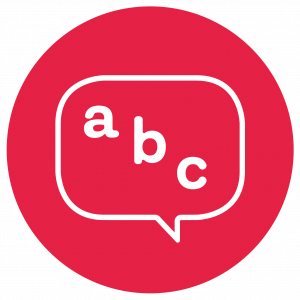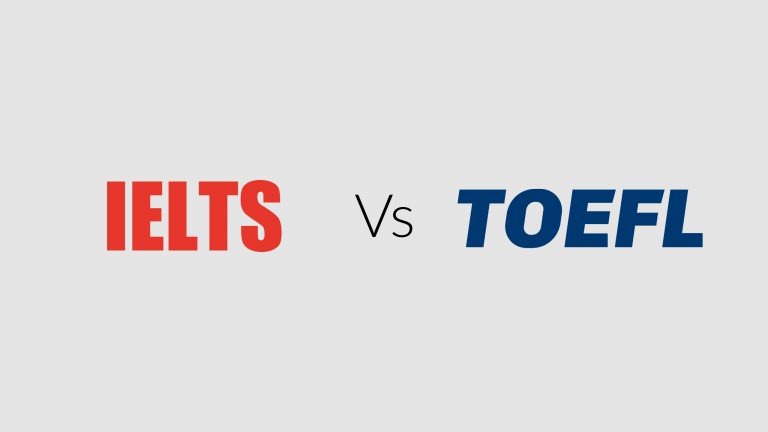
IELTS or TOEFL?
IELTS is not the only exam that you can take to prove your level of English. TOEFL is also a well-established test of academic English and is accepted in thousands of universities worldwide. So, which is the best exam for you? IELTS or TOEFL? Well, that’s what we will be discussing today as we take a deep-dive into the world of TOEFL to show you how it is similar and different to IELTS.
Below, you can find a summary of the episode, which includes all of the links to useful materials and the times of each part of the discussion (so you can go directly to the part you want to listen to) 🚀
Subscribe to My IELTS Classroom podcast on Apple podcasts here
Subscribe to My IELTS Classroom on Google podcasts here
Podcast Summary: IELTS or TOEFL?
The Basics of TOEFL
As My IELTS Classroom is a school dedicated to teaching IELTS, we are going to assume that if you are reading this, you already know the basics of the IELTS test (if not, you can go to our Introduction to IELTS post here). However, as the purpose of this post / podcast is to give the most comprehensive comparison between the two exams, we really do need to start by covering the basics of the TOEFL exam:
- Like IELTS, The Test of English as a Foreign Language (TOEFL) is a widely accepted means of proving English-language competence for undergraduate or graduate study at universities in the English-speaking world.
- It was first offered in 1964, the TOEFL is now accepted by over 9,000 universities in more than 130 countries.
- It is run by the Educational Testing Service (ETS), which is an American company. This is why TOEFL is similar to the American High School exams (SAT’s)
- Just like IELTS, there are four papers for reading, listening, writing, and speaking but unlike IELTS these are INTEGRATED so you may have to listen in the writing test and read in the speaking
- Also, unlike IELTS all the modules are taken on a computer, including the speaking (although there is a paper-based in a very small range of countries such as Nigeria, Kyrgyzstan, and Libya)
- The test takes between three hours and 20 minutes and four hours and 10 minutes to complete, including a single 10-minute break.
- You will be given a score out of 30 for each exam, and a total score out of 120.
IELTS or TOEFL: The basic general differences
Even at this early stage, you should be able to notice some key differences between IELTS and TOEFL.
What you can use your TOEFL and IELTS certificates for is NOT the same
Firstly, there is a big difference in what you can use TOEFL for. Whereas there are two version of IELTS (Academic and General Training), which can be used for a range of purposes from proof of English for migration to registering with a professional body, TOEFL can ONLY be used as proof of your level of English to enter university (as can IELTS Academic).
This means that if you are a test-taker who is planning to migrate to Canada or register with the GMC in the UK, TOEFL is not an option for you. Sorry!
If you are trying to migrate to Canada, we are the CLB9 and CLB10 specialists! Click here to find out how we can help.

1. The format of the TOEFL and IELTS tests are different
The format of the IELTS exam is very easy for test-takers to understand. You will have four different tests, each focussing on one skill: writing, speaking, listening and reading.
TOEFL, on the other hand, uses “independent tasks” (i.e. tasks that test one skills) and “integrated” tasks (i.e. tasks that test a mixture of skills). For example, as part of the integrated writing task, you will be asked to read a short text and listen to part of a lecture before you write. You will need to use the information you have read and heard in your writing (we will look at this in more detail in a moment).
This begs the question, which is better – an integrated exam or an independent one? Well, there is no one “better” way to test English, but as most students learn skills separately, the integrated approach can be a new skill to master and not one that comes automatically. Plus, if you have one particularly weak area, for example if you are a slow reader, then you may struggle more in TEOFL as poor reading skills will affect you score in other areas too.
2. There is no human interaction in the TOEFL test
One famous difference between IELTS and TOEFL is that the TOEFL exam famously happens entirely on a computer. This does not mean that the speaking component of the test happens on Zoom or Skype (as the IELTS speaking test may do if you are taking the Computer-based version), but that there is NO HUMAN INTERACTION in the speaking test. Yes, you will be given a question, and yes you will speak your answer out loud, but there will be no live human there listening to your response.
Instead, you will be given a fixed time to answer the questions and your response will be recorded. An examiner will then listen to your response later. The speaking component of the IELTS exam is, however, conducted by a live examiner in person or through a communication application.
3. The timings of the TOEFL test can change
Every IELTS exam taker knows that their listening exam will last for 35 minutes, the reading and writing exams 60 minutes. TOEFL test-takers, however, are not given such clear timeframes, with some tests being longer than others.
This is because there are additional questions in either the reading or the listening section of the TOEFL iBT that are called “experimental questions”. For example, the standard TOEFL reading test consists of only 3 passages and the questions that follow, yet some students will be given a reading test with 4 passages. Students who do not get the longer version of the reading test can look forward to having an additional set of these unmarked “experimental” questions on their listening test.
The reason for these additional sections, of course, is to develop new questions for the test. In other words, TOEFL uses students in a live test to check if future test questions will work or not. I have always been quite shocked by this. IELTS spends thousands of pounds each year pre-testing questions outside of the test room, which I think is the right approach as any extra questions in the exam is taking much needed brain-power from the test-taker.
IELTS or TOEFL?
Those are the basic similarities and differences between the tests and this may be enough for you to have made up your mind if IELTS or TOEFL is the best option for you. But if you are interested in taking a deep-dive with me into TOEFL, let’s now have a look at each of the four sections in the test to see what you will be expected to do and the potential problems you may encounter.
A Deep Dive into TOEFL Writing
Both the IELTS and TOEFL writing tests ask students to complete two tasks. The TOEFL writing section includes an integrated task (20 minutes) and an independent task (30 minutes), for a total of 50 minutes whereas in IELTS student will have to write either a report or a letter in Task One (depending on if you are sitting the general training or academic version) and then an essay in a tab of 60 minutes (you can decide how much time you spend on each task).
In many respects, the Independent task in TOEFL is very similar to Task Two in the IELTS exam as you will be given a prompt and asked to write an essay in response. However, there are some small differences between the tests.
- First, you have less time to write your essay in TOEFL. In IELTS, you should allocate roughly 40 minutes to writing the essay, whereas in TOEFL you are given just 30 minutes. Moreover, even though you have less time, you are expected to write more words in TOEFL, with the minimum word count being 300 as opposed to 250 in IELTS.
- Plus, there are no public band descriptors for TOEFL. That means that you do not know the exact criteria that your essay will be marked against. All we know is that a human grader will consider the quality of you writing in terms of organisation, grammar, spelling, vocabulary, accuracy, and development. In contrast, IELTS prints public band descriptors that clearly show what you are expected to produce in order to be awarded a score for Task Response, Coherence and Cohesion, Lexical Resource, and Grammatical Range and Accuracy.
If you are an IELTS student and do not know what those criteria are, then you are more or less sitting for the test “blind”. You can either go to this page to listen to Nick and I describe the band descriptors, if you can click here to watch my free introductory video.

The Independent Writing Task: The Three Types of Question
Most importantly, whereas there are eight different types of essay that you may be asked to produce in the IELTS exam, there are only three in TOEFL:
Type 1 – Defend an Opinion
Some people believe that money spent on space research benefits all of humanity. Other people take the opposite view and say that money spent on this type of research is wasted. Tell which point of view you agree with and explain why, using specific details and reasons.
Now, if you are an IELTS test-taker then you may immediately recognise this type of question. In the IELTS world, this is what we call a “Discuss both Sides” or “Discuss both views” essay, and you could use exactly the same techniques to address this question “defend an opinion” question as you would a “discuss both views”. In fact, if we look at an IELTS question on the same topic, they are almost identical!
Some people feel that the cost of space exploration is far too high for the benefits it brings. Others argue that space programmes should continue no matter what the cost. Discuss both these views and give your own opinion.
Type 2 – Agree or Disagree
Do you agree or disagree with this statement?
It is much easier to learn in a small class than in a large one.
Use specific examples and reasons to support your answer.
Again, if you are an IELTS test-taker this type of question will look very familiar as it is a basic “Agree / Disagree” question, which appears in both the General Training and Academic IELTS papers. However, this is not surprising. Both IELTS and TOEFL are designed to test if a student is ready to attend a university in an English-speaking country, so the type of essays they ask you to write mirror those that you are asked to write in those institutes.
Discursive and argumentative essays are core elements of Academic English, so it is no wonder that they are included on the curriculum of both exams. However, as we will see, the third essay is slightly different.
Type 3 – Explain the Importance of a development, invention or phenomenon
Developments in transportation such as the automobile have had an enormous impact on modern society. Choose another development in transportation that you think is of great importance. Use specific examples and reasons for your choice.
This type of prompt essentially says, “There are many important X in the world. What do you think is the most important?” and, in some respects, it is close to the IELTS essays that I have christened “Best Way”. However, these questions are definitely unique to TOEFL and are, in my opinion, a combination of a comparison essay and a cause / effect essay.
On the hand, you will have to compare your choice to other options to show why you think it is the most important (so, you may want to compare an aeroplane here to a train), and you will also, most likely, want to give some effects that happened as a result of your chosen invention (i.e air travel has led to the expansion of the tourism industry, and the globalisation of delivery services).
However, even though the third type of essay is unique to TOEFL, I feel that most test-takers would be comfortable writing an academic essay as this is a straight-forward task that most students have experience of. The same cannot be said of the Integrated Task!
- Our GOLD IELTS writing packages contains everything you need to achieve a high score from video lessons and practice activities, to marking and live one-to-one lessons with a native IELTS expert. Find out more here.
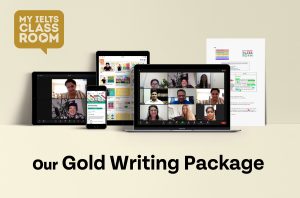
-
The Integrated Writing Task: Introduction
In the second part of the TOEFL test, you will have to compose a written response to a reading passage and a spoken lecture which are based on the same topic. This is not easy and is very different to IELTS where you are either asked to write a letter (General Training) or a report based on a chart (Academic).
The reading passage (200-300 words) typically describes a theory, a concept, a problem, an issue, a system of classification, or a process. You will have three minutes to read and take notes. There are usually THREE main points in the reading – so you really want to make sure that you find and make note of those. Then, you will hear a two minute lecture on the same topic, and again, you are expected to make notes on the main ideas.
The most common pattern is that the information in the lecture and in the reading are in opposition.
In other words, the reading may give you points in favour of a statement while the lecture may give you points against:
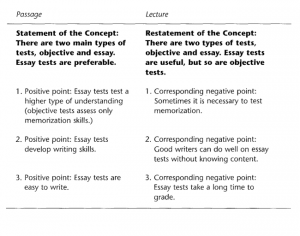 Once you have listened to the lecture, you will be given a question that will ask you to reflect on what you have listened and heard. For example, if the reading and the lecture showed opposite views you may be asked to show how the points in the lecture refute, contradict, or cast doubt on those in the passage.
Once you have listened to the lecture, you will be given a question that will ask you to reflect on what you have listened and heard. For example, if the reading and the lecture showed opposite views you may be asked to show how the points in the lecture refute, contradict, or cast doubt on those in the passage.
What makes the integrated task very different to the independent task is that you must not give your own opinion or add any information that comes from your general knowledge outside the passage or tapescript.
That is why it is so important that you identify the main topic and the supporting arguments in the reading before you listen to the lecture – this will help you to listen out for the opposite arguments. There can be other types of question (in which the 2 passages don’t contradict) that ask you to
- explain how the lecture illustrates the reading
- explain how the points in the lecture solve the problem described in the reading,
- explain how the points in the lecture are the results of an event in the reading.
However, no mater what the focus of the reading and listening material is, to get a high score you will need to demonstrate that you can
- identify key points and supporting info
- summarise and paraphrase material
- synthesise material from the lecture and passage
- organise your response
The Integrated Writing Task: Three Main Problems
On the one hand, you may think that the integrated task is easier than the independent one as you do not need to generate the ideas for the writing yourself. This is definitely true. However, there are three main problems facing students in this part of the test.
1. The test-taker missed the corresponding points in the lecture.The point of the integrated task is to see if you can summarise and paraphrase information that you have read and heard. Thus, if your notes are not detailed enough or are missing vital information, it is impossible to achieve the highest scores as you must include these details.
2. The test-taker gives their own opinion in the writing. You have the chance to write about your own thoughts and feelings in the Independent Task. You should never do it in the integrated task. In particular, many students often write sentences like those that are found in the independent Discussion Essay:
Some people think X, while others think Y.
This is a mistake. There are NO people in the integrated task! There is just the reading material and the lecturer. Instead, you have to learn how to cite where the information in your essay came from:
- Listening: According to the lecturer…….. / The lecturer stated that……….
- Reading: The passage says that……… / The text claims that……….
3. The test-taker copies rather than paraphrase. Another problem in the integrated task is that you can see the reading material as you write. The temptation, then, is simply to either copy the reading material OR translate it word for word. This is a mistake.
Paraphrasing doesn’t mean that EVERY word in the passage changes (how, for example, could you paraphrase the word “photosynthesis” without writing a ridiculously long clause?) but you should be prepared to change the word order of a sentence and use clear synonyms when possible.
If you are looking for a clear guide to paraphrasing, you can listen to this episode of the My IELTS Classroom podcast. Even though it is aimed at IELTS students, the skills are exactly the same as those needed in TOEFL
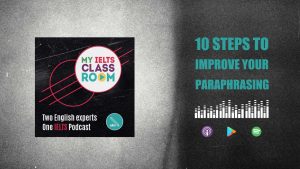
IELTS or TEOFL?
Overall, if you are making a decision between IELTS or TOEFL, the main difference in terms of writing is the integrated task. For good listeners and readers, it will be relatively simple as the structure is straightforward- you will just discuss one idea from the reading material and its opposing idea from the lecture inside one paragraph. Of course, you should have a short introduction and conclusion, but these need to simply state what the main topics discussed are. In other words, what you produce will be short and more or less just a summary of what you heard and read.
However, if you find it difficult to locate main ideas quickly and to paraphrase, then the IELTS report or letter may be a better option for you.
A Deep Dive into TOEFL Speaking
A quick overview of IELTS Speaking
Speaking is the skill where I feel that IELTS and TOEFL differ most in their approach to testing. In the IELTS exam, you are interviewed face-to-face by a human examiner. Until recently, this interview always happened in real-life in a room, but after COVID and thanks to developments in technology, some exams are now performed over a computer in a Zoom-like call. However, in any case, you will be talking to a “real” examiner who will take you through three sections of the test in 11 – 14 minutes.
- In Part One, the examiner will ask you questions on up to three personal topics. All the questions require you to talk about your own life and are on familiar topics e.g. daily habits, likes, work, etc. Part One lasts up to 5 minutes.
- In Part Two, the examiner will ask you to speak for between one and two minutes about a particular topic that is given to you on a cue-card. You will have one minute to prepare before you speak. You may make notes during this time. Part Two lasts up to 4 minutes.
- Finally, in Part 3, you will have a discussion of a more abstract nature with the examiner. The questions in this part are based on the same topic as Part 2. Part Three lasts up to 5 minutes.
At the end of the test, the examiner who conducted your interview will then give you a score from 0 – 9 in four areas: Fluency and Coherence, Lexical Resource, Grammatical range and Accuracy, and Pronunciation. Your final overall score will be the average of these four scores rounded down.
If you would like to know more about the IELTS speaking exam, we have dozens of useful blog posts here (just click on “speaking” in the menu. However, this IELTS 101 episode gives a very comprehensive overview of what is expected of you in the test. Today though, the main thing to remember is that in the IELTS exam you will be interviewed by a human examiner who, just like writing, will give you a score in four areas based on public band descriptors.
- Fluency and Coherence (i.e. how easily you can speak and be understood)
- Lexical Resource (i.e. the level of the vocabulary you use in your responses)
- Grammatical Range and Accuracy (i.e. the level of the sentence structures in your responses)
- Pronunciation (i.e. how easily you can be understood and how well you use your voice to stress the importance of information)
An Introduction to TOEFL Speaking
The TOEFL speaking exam is very different. You will have 20 minutes to complete two independent tasks and four integrated tasks. However,
it is taken fully on a computer with no human interaction at all.
For each task, you will be given some preparation time (15 seconds – 30 seconds) and then a beep will signal that you are expected to start your response. You will speak your response into a microphone, which will record your words so that they can be assessed later by a human marker. Other test takers in the room will be doing the same thing, so you need to learn to ignore them as you speak.
All of the tasks that you are asked to do are based on what you have to do at university:
- answer questions
- contribute to classroom discussions
- summarize lectures
- reading assignments
- express their own views
- and function in situations commonly encountered in university life.
Again, just like writing, the independent tasks are based on your own knowledge and the integrated tasks are based on the notes you make from information provided by short passages or listening texts. Also, just like writing, the recording of your speaking will also be marked by a human examiner. However, the speaking exercises are not marked by one examiner (like in IELTS) but between three and six. Presumably, each small recording is sent to a different person. Again, there are no public band descriptors for TOEFL speaking. All we know is that you will be assessed according to
- Delivery of Response (fluency, pronunciation, intonation)
- Use of Language (grammar, vocabulary, idioms)
- Development of Topic (coherent, has a clear position, provides evidence and examples)
Independent TOEFL Speaking Tasks
As I mentioned above, the first two speaking tasks are “independent”, which means that you will respond to a prompt using your own ideas and experiences.
Task 1: Personal Preference
The first task asks you to express a personal choice from a category. That sounds quite complicated, but really the questions are very simple and usually focus on the use of superlatives i.e. the most interesting, or the best . For example, you may be asked to describe the most important day in your life and explain why it was important to you, or you may be asked to describe your most important skill and why it is so important to you.

Just like like IELTS Speaking Part One, as all of the questions are about you and your personal experience, this task should not present a challenge for most test-takers. You should just be prepare to
- give descriptions of people, places and things.
- narrate an event or action
- express a preference
Task 2: Paired Choice
In Task 2, you will be given two choices and asked to express a personal preference. For example, you may be asked to discuss two styles of work and explain which you prefer:
Some people prefer to work for a company while some people prefer to work for themselves. Explain which of these you prefer and why. Include details and examples in your explanation.
Clearly, this task is focusing on your ability to compare and contrast, and also to express a personal opinion with examples and reasons. The paired choice question does not aways focus on your preference though, as it may also ask you to choose an opinion or policy you most agree with:
Some high schools and elementary schools require their students to wear school uniforms. Other schools let their students wear whatever clothing they want. Which of these two policies do you agree with, and why? Include details and examples in your explanation.
In general, I don’t think that the paired choice question is difficult, but remember that you only have 45 seconds to deliver your answer and the the computer will automatically shut off and stop recording. This “time-pressured” speaking is not natural, so it is something that you should practice before sitting the test so that you can get to know what speaking for that length of time feels like.
Integrated TOEFL Speaking Tasks
The remaining four speaking tasks are all integrated. However, just to make things more complicated, they do not all require you to read and listen before you speak
- Task 3 (on campus) & Task 4 (academic) ask you to read something, listen to something and then report what you read and heard. (30 seconds to prepare, 60 seconds to respond).
- Task 5 (on campus) & Task 6 (academic) ask you to listen only. (20 seconds to prepare, 60 seconds to respond.
Again, just like the integrated writing tasks, you must ONLY report what you read and heard (i.e. you must not add your own ideas) and you must take care to make sure you do this in your own words (i.e. you need to paraphrase and not simply regurgitate).
And, just like in writing, you must take care that you cite where the information you are giving came from i.e. was it from the reading passage the lecture, using language like “The author informs us that ……….” OR “The male student says………” OR “According to the lecturer……….”. In other words, the integrated speaking tasks test your ability to read and listen almost as much as they do your ability to speak.
Task 3 – Announcement / Discussion
Task 3 is based on “life on campus” and tests your ability to understand official notices. You will have 45 seconds to read a notice about a new regulation or a policy change (for example, you might read that the university parking policy has changed or that there are new rules about plagiarism) and then you will hear 2 students discussing the notice (60 – 80 seconds).
You will then be asked to REPORT what ONE student said. The trick? You don’t know which student you will have to report until after you have heard them speak. You will be given 30 seconds to prepare, and then 60 seconds to speak. This task relies heavily on you being able to use epode speech, so this is what i would focus on your preparation (and this is not something that is really tested in IELTS)
Task 4 – General / Specific
Task 4 is a combination of reading and listening. The reading comes from a textbook or article and will describe general theory or phenomenon. Think this as the introduction to the topic. Then, you will hear part of a lecture in which a professor will give a specific example of the concept or theory or a real-world application of the theory. When the recording ends, you will need to summarise the reading and lecture and, most importantly, show the relationship between the two.
I think that this is one of the most challenging tasks as you only have 30 seconds preparation time and it can be hard to draw the connections between the general and the specific in such a short amount of time.
Task 5 – Problem / Solution
Again, this is a listening only task. You will hear two speakers (usually two students) discussing one problem and giving two possible solutions. You should take notes so that afterwards you are able to
- Describe the problem (in your own words)
- Paraphrase the 1st possible solution + react to it
- Paraphrase the 2nd possible solution + react to it
- State your recommendation and give a reason for making it
At the end when you give your own solution, you are welcome to reject both of the ideas given in the recording and give your own alternative. The is important as
this is the only integrated task where you can give your own view
This task is called “on campus” so the problem and solutions you hear will be of a personal nature. For example,
- Problem – one of students is exhausted
- Solution 1 – drink coffee (they discuss that the coffee from the vending machine tastes terrible, and it is expensive if you buy one every day)
- Solution 2 – take a nap in the afternoon (they discuss that it is a long way to go back to the dorm room)
Task 6 – Summarising
You will hear a 90 – 120 second snippet from a lecture or a classroom discussion. You must summarise the main points made and use any examples given to illustrate the main points.

IELTS or TEOFL?
I have always felt that the IELTS exam does a much better job of testing a student’s ability to speak than TOEFL. While I admire the fact that the TOEFL test is attempting to mimic the type of speaking that students will engage in on campus, I just think that speaking into a microphone is not natural.
Also, the time given for you to process the reading and listening passages and to synthesise them together is, in my opinion, too short and can be challenging even for native speakers. I am not saying that the TOEFL speaking is impossible, but I do think that if you are a strong speaker, you will deal with the IELTS speaking test far more easily and naturally than the TOEFL one.
If you are studying IELTS we offer a range of speaking courses from 30-minute mock tests to 5-day intensive courses and personal lessons. Click here to find out more.
If you would like to continue this lesson and find out more about the differences between IELTS and TOEFL in terms of reading and listening, then you can listen to the full episode here:
Nick and I will discuss the difference between explicitly ad implicitly testing reading skills, and how the notes you make for TOEFL listening are not the same as those you would take in a real-life lecture.
